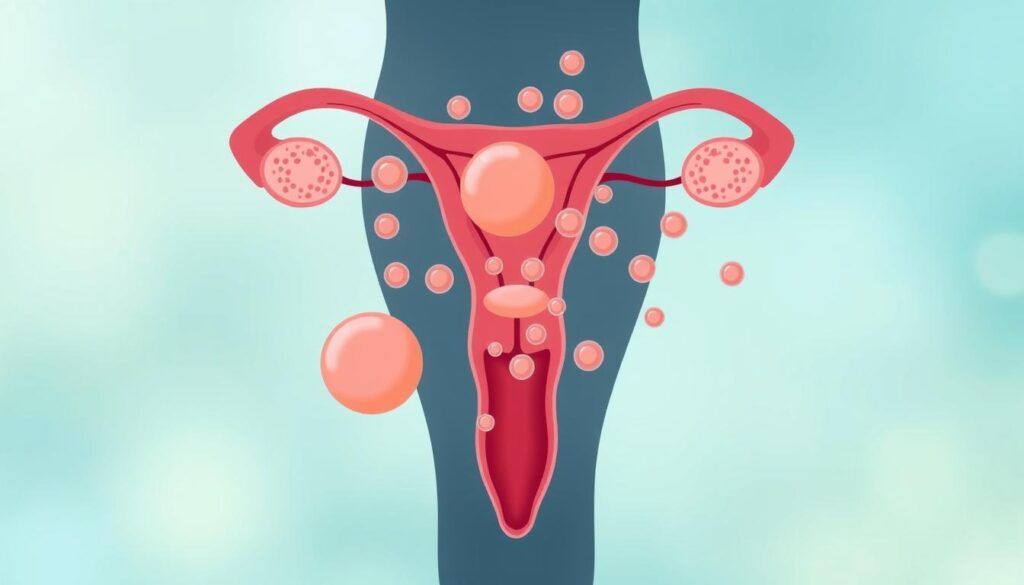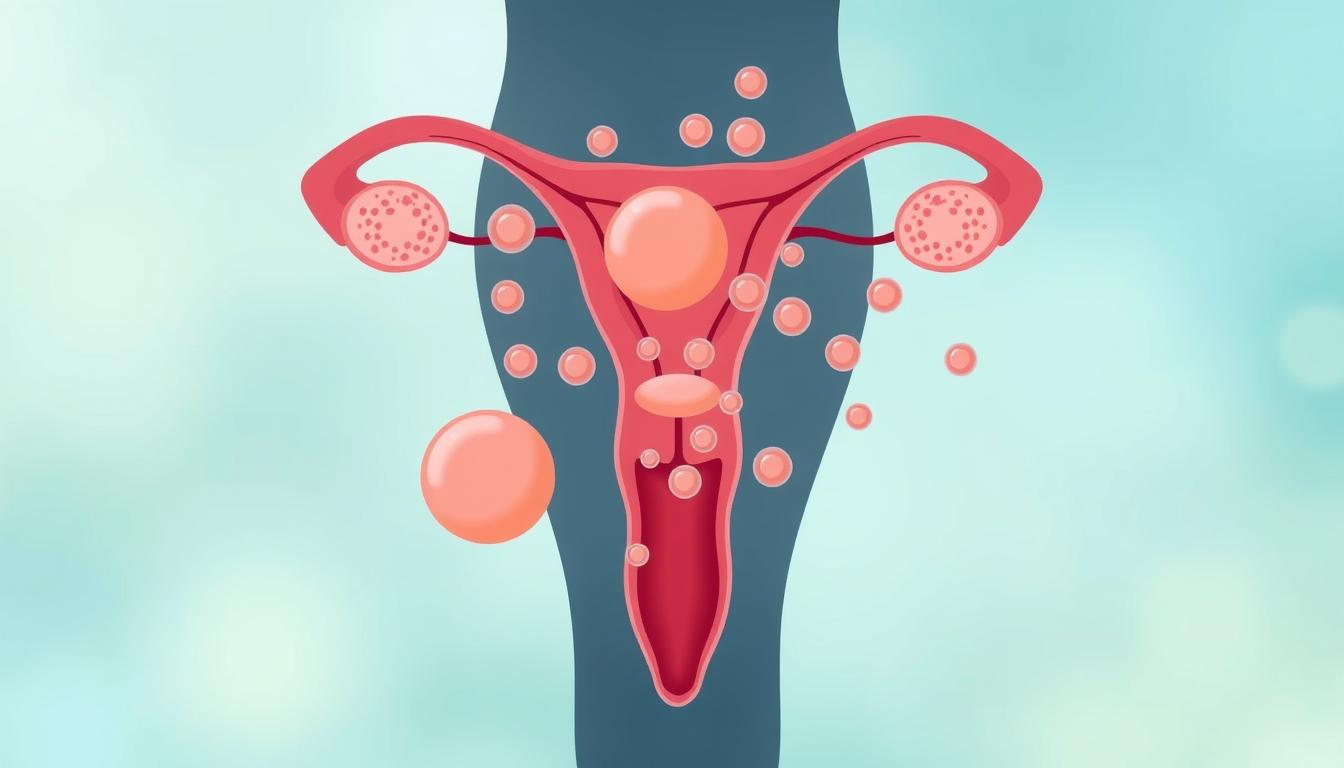Polycystic Ovary Syndrome (PCOS) is a common endocrine disorder in women of childbearing age. It causes hormonal and metabolic problems. The ICD-10 code, E28.2, helps doctors diagnose and manage PCOS.
PCOS affects a woman’s health in many ways. It can cause irregular periods, infertility, and increase the risk of diabetes. Understanding PCOS and its coding is key to managing these issues.
Key Takeaways
- PCOS is a common endocrine disorder affecting women of reproductive age
- The ICD-10 code E28.2 is used to diagnose and classify PCOS
- Accurate PCOS coding is crucial for effective treatment, management, and insurance coverage
- Understanding the clinical features and diagnostic criteria of PCOS is essential for healthcare providers
- PCOS can lead to a wide range of complications, making early detection and proper coding critical
Understanding PCOS ICD 10 and Its Clinical Significance
Polycystic Ovary Syndrome (PCOS) is a complex disorder that affects women of childbearing age. The codes used to identify PCOS have changed over time. This shows how our understanding of the condition has grown.
Evolution of PCOS Diagnostic Codes
The codes for PCOS have been updated to improve medical records. At first, PCOS was listed under the ICD-9 code 256.4. This code covered many ovarian issues. But, the ICD-10 system introduced in 2015 brought more specific codes. These better describe the different symptoms of pcos icd 10.
Importance of Accurate Medical Coding
Accurate medical coding is key for healthcare. It helps in diagnosing, treating, and getting insurance for PCOS patients. Using the right diagnostic criteria ensures the pcos icd 10 codes match the patient’s condition. This helps patients get the right care and payment.
Current ICD-10 Classifications for PCOS
The ICD-10 system now has several codes for PCOS. These include:
- E28.2 – Polycystic ovarian syndrome
- E28.8 – Other specified ovarian dysfunction
- E28.9 – Ovarian dysfunction, unspecified
These codes help doctors document PCOS symptoms. This leads to better patient care and helps in research and public health.
Key Clinical Features and Diagnostic Criteria of PCOS
Polycystic Ovary Syndrome (PCOS) is a complex hormonal disorder. It has unique clinical features. Healthcare providers use the Rotterdam criteria to diagnose PCOS. These criteria were set by the European Society of Human Reproduction and Embryology and the American Society for Reproductive Medicine.
The main features of PCOS include:
- Hormonal Imbalances: High levels of androgens, like testosterone, cause symptoms. These include hirsutism (excessive hair growth), acne, and male-pattern baldness.
- Ovarian Cysts: PCOS is marked by multiple small fluid-filled sacs, or cysts, on the ovaries. These are seen on ultrasound.
- Menstrual Irregularities: Irregular or infrequent menstrual cycles, known as oligomenorrhea, are common. Some may also have absent periods, or amenorrhea.
To diagnose PCOS, healthcare providers look for at least two of the following:
- Oligo- or anovulation (irregular or absent ovulation)
- Clinical and/or biochemical signs of hyperandrogenism (excess androgen production)
- Polycystic ovarian morphology on ultrasound examination
These features, along with ruling out other causes, help in diagnosing PCOS. This leads to a proper treatment plan.
| Clinical Feature | Description |
|---|---|
| Hormonal Imbalances | Elevated levels of androgens, such as testosterone, can lead to symptoms like hirsutism, acne, and male-pattern baldness. |
| Ovarian Cysts | The presence of multiple small fluid-filled sacs, or cysts, on one or both ovaries, visible on ultrasound examination. |
| Menstrual Irregularities | Irregular or infrequent menstrual cycles (oligomenorrhea) or absent periods (amenorrhea). |
Primary PCOS Symptoms and Their Impact on Diagnosis
Polycystic Ovary Syndrome (PCOS) is a complex endocrine disorder. It has many symptoms that can greatly affect a woman’s health. Knowing the main PCOS symptoms and their importance is key for accurate diagnosis and treatment.
Menstrual Irregularities and Ovulation Problems
One key sign of PCOS is irregular periods, like oligomenorrhea or amenorrhea. These issues often come from ovulation problems. This can make it hard to get pregnant.
Hyperandrogenism Manifestations
PCOS also leads to too much of male hormones, or androgens, in women. This can cause hirsutism (too much hair), acne, and even male-pattern baldness.
Polycystic Ovarian Morphology
PCOS is marked by many small cysts on the ovaries, known as polycystic ovarian morphology. These cysts are seen on ultrasound and are key in diagnosing PCOS.
It’s vital to correctly identify and document these symptoms for ICD-10 coding. This ensures patients get the right care and support. Understanding these symptoms helps healthcare providers better manage PCOS.
Common PCOS Complications and Associated Conditions
Polycystic Ovary Syndrome (PCOS) is a complex hormonal disorder. It can lead to various health complications if not treated. At the top of these issues are insulin resistance, obesity, and metabolic disorders.
Insulin resistance is a key feature of PCOS. It makes the body’s cells less responsive to insulin. This can lead to type 2 diabetes, a serious condition that needs careful management. Obesity, another common problem, can make insulin resistance worse. It also raises the risk of cardiovascular disease, high blood pressure, and certain types of cancer.
PCOS also causes infertility, mood disorders like depression and anxiety, and skin conditions such as acne and hirsutism (excessive hair growth).
| PCOS Complication | Associated Condition |
|---|---|
| Insulin Resistance | Type 2 Diabetes |
| Obesity | Cardiovascular Disease, High Blood Pressure, Cancer |
| Infertility | – |
| Mood Disorders | Depression, Anxiety |
| Skin Conditions | Acne, Hirsutism |
It’s important to recognize and treat these PCOS-related complications. This is key to providing full care and improving health and well-being for those with this condition.
Different Types of PCOS and Their Specific ICD-10 Codes
Polycystic Ovary Syndrome (PCOS) is a complex endocrine disorder. It has many clinical manifestations. While classical PCOS is well-known, there are non-classical variants that need different diagnostic approaches and coding.
Classical PCOS Coding
The classical PCOS ICD-10 codes cover the main features of the condition. These include hyperandrogenism, menstrual irregularities, and polycystic ovarian morphology. The main code for classical PCOS is E28.2, which is under “Polycystic ovarian syndrome.”
Non-Classical PCOS Variants
Healthcare providers also see non-classical or adrenal PCOS variants. These have unique hormonal profiles and clinical signs. They need different ICD-10 codes for accurate diagnosis and reporting.
Related Endocrine Disorders
PCOS is often linked with other endocrine disorders. These include insulin resistance, metabolic syndrome, and hypothyroidism. Proper coding of these comorbidities is key for comprehensive patient care and insurance coverage.
| PCOS Variant | ICD-10 Code | Description |
|---|---|---|
| Classical PCOS | E28.2 | Polycystic ovarian syndrome |
| Non-Classical PCOS | E25.0 | Congenital adrenal hyperplasia |
| Insulin Resistance | E11.65 | Type 2 diabetes mellitus with hyperglycemia |
| Metabolic Syndrome | E88.81 | Metabolic syndrome |
| Hypothyroidism | E03.9 | Hypothyroidism, unspecified |
It’s important for healthcare providers, medical coders, and insurance specialists to know the ICD-10 codes for different PCOS subtypes and related endocrine disorders. This ensures accurate diagnosis, treatment, and reimbursement.
Diagnostic Tests and Procedures for PCOS Confirmation
Diagnosing polycystic ovary syndrome (PCOS) requires a detailed look at symptoms and tests. The pcos symptoms quiz, a physical exam, and lab tests are key. They help identify PCOS and guide ICD-10 coding.
Blood tests are a main tool for diagnosing PCOS. They check testosterone and androgen levels. Tests for luteinizing hormone (LH) and follicle-stimulating hormone (FSH) also help. These tests spot ovarian cysts and hormonal imbalances linked to PCOS.
Imaging, like transvaginal ultrasound, is also vital. It lets doctors see the ovaries. They look for polycystic ovarian morphology, with many small follicles.
| Diagnostic Test | Purpose |
|---|---|
| Blood Tests | Measure hormone levels, including testosterone, LH, and FSH, to assess hormonal imbalances |
| Transvaginal Ultrasound | Visualize the ovaries and detect the presence of polycystic ovarian morphology |
| Physical Examination | Assess for signs of hyperandrogenism, such as acne, hirsutism, and male-pattern baldness |
Doctors also do physical exams. They look for signs like acne, hirsutism, and male-pattern baldness. These tests, along with the patient’s history, help confirm PCOS. They ensure the right ICD-10 coding.
Knowing how PCOS is diagnosed helps people get medical help. They can get the right treatment for their pcos symptoms quiz and health issues.
Treatment Options and Management Strategies
Living with polycystic ovary syndrome (PCOS) means you need a plan that covers all bases. This plan helps with can’t sleep pcos pain, insulin resistance, and obesity. It’s all about tackling the symptoms and complications head-on.
Lifestyle Modifications
Starting with a healthy lifestyle is key. This includes:
- Eating a balanced, low-glycemic diet to control insulin and manage weight
- Doing regular strength training and cardiovascular exercises to boost insulin sensitivity
- Using stress management like yoga and meditation to keep hormones in check
Medical Interventions
Healthcare experts also suggest medical treatments. These are tailored to meet PCOS patients’ needs. They might include:
- Medicines to fix menstrual issues, can’t sleep pcos pain, and insulin resistance, like oral contraceptives and metformin
- Drugs for hyperandrogenism, such as anti-androgen meds and spironolactone
- Options for fertility, like ovulation induction and in vitro fertilization, for those wanting to have kids
Alternative Therapies
Some people with PCOS try alternative therapies too. These can be part of their management plan. They might include:
- Herbal supplements and nutritional supplements to balance hormones and ease can’t sleep pcos pain
- Acupuncture and Traditional Chinese Medicine to tackle symptoms and boost well-being
- Mind-body practices, like mindfulness and relaxation techniques, to handle stress and fight insulin resistance
By mixing lifestyle changes, medical treatments, and alternative therapies, people with PCOS can manage their symptoms. This improves their health and quality of life.

Insurance Coverage and Medical Billing Considerations
Managing polycystic ovary syndrome (PCOS) can be costly. It’s important to understand medical coding and insurance to get the care you need. Knowing about PCOS ICD-10 codes helps you deal with insurance claims better.
The International Classification of Diseases, Tenth Revision (ICD-10) helps code medical conditions, including PCOS. Accurate coding is key. It tracks PCOS and affects insurance coverage. Wrong coding can cause denied claims and financial stress.
- PCOS is coded as E28.2 Polycystic ovarian syndrome in ICD-10. This covers all its symptoms.
- Some PCOS types or related issues have their own ICD-10 codes. For example, E28.1 Excessive androgen secretion or E28.8 Other ovarian dysfunction.
- Healthcare providers must document and code correctly. This ensures insurance covers PCOS treatments and procedures.
Insurance for PCOS care varies by plan and location. Some plans cover a lot, while others don’t. It’s important for PCOS patients to check their insurance and fight for the care they need.
Knowing about PCOS ICD-10 coding and insurance helps manage PCOS better. It lets you get the treatments you need and reduces financial stress.
Latest Research and Advancements in PCOS Understanding
In recent years, there has been a big leap in understanding polycystic ovary syndrome (PCOS). This is a common endocrine disorder that impacts women’s health. Scientists are working hard to find better ways to diagnose and treat PCOS.
New ways to diagnose PCOS have come up. Tools like 3D ultrasound and MRI help doctors see the ovaries better. They also use biomarkers like AMH and androgen levels to spot PCOS.
Research has also focused on the metabolic disorders linked to PCOS. It’s found that insulin resistance, inflammation, and genetics play big roles. This knowledge helps doctors create more specific treatment plans, including lifestyle changes and new medicines.
| Recent PCOS Research Highlights | Key Findings |
|---|---|
| Precision medicine in PCOS | Identification of genetic and metabolic subtypes to guide personalized care |
| Innovative diagnostic tools | Advanced imaging, biomarkers, and integrated assessment approaches |
| Expanded treatment options | Novel pharmacotherapies, inositol supplements, and lifestyle interventions |
As we learn more about polycystic ovary syndrome, doctors and scientists are getting better at helping those with it. These new findings could lead to better ways to diagnose and treat PCOS. They might also change how PCOS care is covered by insurance.
Patient Resources and Support Systems
Living with polycystic ovary syndrome (PCOS) can be tough, but you’re not alone. There are many resources and support systems to help. They can help you understand your condition, manage symptoms like pcos symptoms quiz, and deal with issues like can’t sleep pcos pain and infertility.
One key resource is educational materials. Websites, guides, webinars, and podcasts offer a lot of information. They help you learn about PCOS diagnosis and treatment. This knowledge empowers you to speak up for your health needs.
PCOS support groups are also very important. They connect you with others who understand what you’re going through. Online and local groups let you share experiences, get support, and learn from others. Being part of a support group can make you feel less alone and help you talk openly about PCOS challenges.
| Resource | Description | Link |
|---|---|---|
| PCOS Awareness Association | Non-profit organization providing education, support, and advocacy for PCOS | https://www.pcosaa.org/ |
| PCOS Challenge: The National Polycystic Ovary Syndrome Association | Patient-centered organization offering resources, support, and community for those with PCOS | https://www.pcosChallenge.org/ |
| PCOS Nutrition Center | Provides evidence-based information, counseling, and support for PCOS management | https://www.pcosnutrition.com/ |
By using these resources and support systems, people with PCOS can learn more about their condition. They can connect with others and improve their well-being and life quality.
TO WATCH THE VIDEO CLICK HERE
Conclusion
Exploring PCOS ICD-10 codes shows how crucial accurate coding is. It helps in diagnosing, treating, and managing this complex disorder. The evolution of these codes helps doctors better understand and treat PCOS, leading to better care for patients.
Accurate ICD-10 coding for PCOS also affects insurance and healthcare costs. Keeping up with the latest codes ensures patients get the right care and support. This is vital for managing PCOS effectively.
As we learn more about PCOS, the need for accurate coding will grow. By understanding and using ICD-10 codes well, we help healthcare providers and patients. This effort improves the lives of those with polycystic ovary syndrome.
FAQ
What is the ICD-10 code for Polycystic Ovary Syndrome (PCOS)?
The ICD-10 code for Polycystic Ovary Syndrome (PCOS) is E28.2.
Why is the ICD-10 code for PCOS important?
The ICD-10 code for PCOS is key for medical diagnosis and billing. It helps doctors document the condition correctly. It also ensures insurance covers PCOS treatments and services.
What are the key clinical features of PCOS?
PCOS symptoms include irregular periods, ovulation issues, and high male hormones. These signs help doctors diagnose PCOS and use the right ICD-10 code.
What are the different types of PCOS and their specific ICD-10 codes?
PCOS types include classical and non-classical forms, along with related endocrine disorders. Each type has its ICD-10 code. This helps doctors document the specific PCOS type and any related conditions.
What diagnostic tests are used to confirm a PCOS diagnosis?
Tests for PCOS include blood hormone tests and pelvic ultrasounds. Physical exams also help. These tests help doctors diagnose PCOS accurately and assign the right ICD-10 code.
What are the treatment options for PCOS?
PCOS treatments include diet, exercise, and medication. Hormone therapy and alternative therapies like acupuncture are also options. The treatment plan depends on the patient’s symptoms and ICD-10 code.
How does insurance coverage and medical billing work for PCOS patients?
Insurance and billing for PCOS patients rely on accurate ICD-10 coding. Proper coding ensures coverage and reimbursement for PCOS treatments and services.
TO EXPLORE MORE TOPICS CLICK HERE



